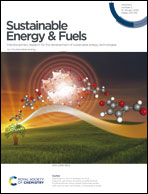Highly ionic conductive and mechanically strong MXene/CNF membranes for osmotic energy conversion†
Abstract
Controllable ion transport in nanofluidic membranes is highly desirable for industrial applications, including energy harvesting, molecular separation, and nanofiltration. However, the nanofluidic materials synthesized using the traditional approach still suffer from complex preparation, insufficient charge density, and poor aqueous stability. Herein, we describe a mechanically robust nanofluidic membrane coupled with highly charged lamellar nanochannels, which is formed through the sequential bridging and alignment of MXene nanosheets and TEMPO-oxidized cellulose nanofibers (MXene/CNF). The ion conductivity of the MXene/CNF membrane reached up to 4 × 10−3 S cm−1 at a low KCl concentration, while its tensile strength was as high as 171.2 MPa. The MXene/CNF membrane also showed prominent aqueous stability and maintained its high ion conductivity over a period of 10 days. Moreover, an osmotic energy generator based on the MXene/CNF membrane yielded the maximum output power density of 0.15 W m−2 at 1000-fold concentration gradient. The results demonstrated that the MXene/CNF-based nanofluidic membrane can be effectively utilized in the development of high-performance osmotic energy conversion devices.



 Please wait while we load your content...
Please wait while we load your content...